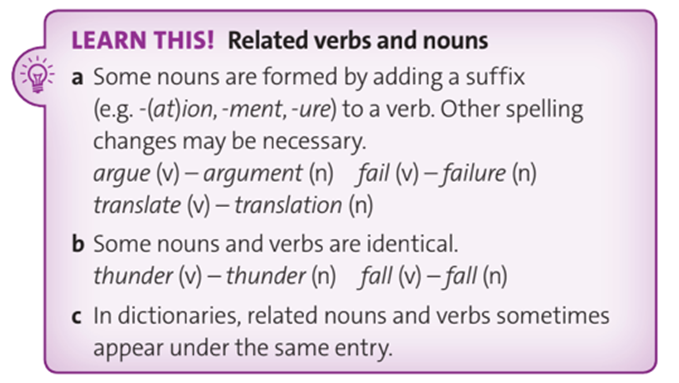Câu hỏi:
22/07/2024 140
Read the Learn this! box. Which different noun suffixes can you find in the text in exercise 1? Which nouns do not have a suffix? (Đọc bảng Learn this. Bạn có thể tìm thấy những hậu tố của danh từ khác nhau nào trong đoạn văn ở bài tập 1? Những danh từ nào không có hậu tố?)

Read the Learn this! box. Which different noun suffixes can you find in the text in exercise 1? Which nouns do not have a suffix? (Đọc bảng Learn this. Bạn có thể tìm thấy những hậu tố của danh từ khác nhau nào trong đoạn văn ở bài tập 1? Những danh từ nào không có hậu tố?)

Trả lời:
 Giải bởi Vietjack
Giải bởi Vietjack
Hướng dẫn dịch: Động từ và danh từ có liên quan
a. Một số danh từ được tạo thành bằng cách thêm hậu tố vào sau động từ.
(ví dụ: -(at) ion, -ment, -ure) Có thể sẽ cần những thay đổi chính tả.
- argue(v) - argument (n) (tranh cãi)
- fail (v) - failure (n) (thất bại)
- translate (v) – translation (n) (dịch)
b. Một số danh từ và động từ giống hệt nhau.
- thunder (v) -thunder (n) (sấm sét)
- fall (v) -fall (n) (ngã)
c. Trong từ điển, các danh từ và động từ có liên quan đôi khi sẽ xuất hiện ở trong cùng một mục.
Đáp án:
-ion: exploration
-ure: adventure
no suffix: attempt
Hướng dẫn dịch: Động từ và danh từ có liên quan
a. Một số danh từ được tạo thành bằng cách thêm hậu tố vào sau động từ.
(ví dụ: -(at) ion, -ment, -ure) Có thể sẽ cần những thay đổi chính tả.
- argue(v) - argument (n) (tranh cãi)
- fail (v) - failure (n) (thất bại)
- translate (v) – translation (n) (dịch)
b. Một số danh từ và động từ giống hệt nhau.
- thunder (v) -thunder (n) (sấm sét)
- fall (v) -fall (n) (ngã)
c. Trong từ điển, các danh từ và động từ có liên quan đôi khi sẽ xuất hiện ở trong cùng một mục.
Đáp án:
-ion: exploration
-ure: adventure
no suffix: attempt
CÂU HỎI HOT CÙNG CHỦ ĐỀ
Câu 1:
Complete the table with words from the text in exercise 1. (Hoàn thành bảng với các từ trong đoạn văn ở bài tập 1)
Complete the table with words from the text in exercise 1. (Hoàn thành bảng với các từ trong đoạn văn ở bài tập 1)
Câu 2:
Dictionary work. Work in pairs. Using a dictionary, find the nouns related to the verbs below. Check their meanings. (Từ điển. Làm việc theo cặp. Sử dụng từ điển, tìm các danh từ của các động từ bên dưới. Kiểm tra nghĩa của chúng)
Dictionary work. Work in pairs. Using a dictionary, find the nouns related to the verbs below. Check their meanings. (Từ điển. Làm việc theo cặp. Sử dụng từ điển, tìm các danh từ của các động từ bên dưới. Kiểm tra nghĩa của chúng)
Câu 3:
Speaking. Work in pairs. Check your answers to exercise 6. Then discuss whether you agree or disagree with the sentences. (Nói. Làm việc theo cặp. Kiểm tra câu trả lời của bạn cho bài tập 6. Sau đó thảo luận xem bạn đồng ý hay không đồng ý với những câu đó)
Speaking. Work in pairs. Check your answers to exercise 6. Then discuss whether you agree or disagree with the sentences. (Nói. Làm việc theo cặp. Kiểm tra câu trả lời của bạn cho bài tập 6. Sau đó thảo luận xem bạn đồng ý hay không đồng ý với những câu đó)
Câu 4:
Read the text. Find the name of the person in the photo. Do you agree with the theory at the end? Why? / Why not? (Đọc đoạn văn. Tìm tên của người trong bức anh. Bạn có đồng ý với lý thuyết ở cuối không? Tại sao? / Tại sao không?)

Read the text. Find the name of the person in the photo. Do you agree with the theory at the end? Why? / Why not? (Đọc đoạn văn. Tìm tên của người trong bức anh. Bạn có đồng ý với lý thuyết ở cuối không? Tại sao? / Tại sao không?)

Câu 5:
Pronunciation. Listen to the words and underline the stress. Then work in pairs. Take it in turns to say a word and say the form. (Cách phát âm. Nghe các từ và gạch dưới trọng âm. Sau đó làm việc theo cặp. Lần lượt nói một từ và nói theo mẫu)
Pronunciation. Listen to the words and underline the stress. Then work in pairs. Take it in turns to say a word and say the form. (Cách phát âm. Nghe các từ và gạch dưới trọng âm. Sau đó làm việc theo cặp. Lần lượt nói một từ và nói theo mẫu)
Câu 6:
Complete sentence b in each pair with the correct noun formed from the underlined verb in sentence a. Use a dictionary to help you if necessary. (Hoàn thành câu b với danh từ được tạo thành từ động từ gạch chân trong câu a. Sử dụng từ điển nếu cần thiết)
1. a. Teenagers who go on adventures should be proud of what they accomplish,
b. Teenagers who go on adventures should be proud of their _______.
2. a. Companies will want to employ them.
b. Companies will want to offer them _______.
3. a. Preparing for the trips is the most difficult part.
b. The most difficult part of the trips is the _______.
4. a. These trips are a great way to develop personal skills.
b. These trips are great for the _______ of personal skills.
5. a. Most teenagers dream of becoming famous.
b. The _______ of most teenagers is to become famous.
Complete sentence b in each pair with the correct noun formed from the underlined verb in sentence a. Use a dictionary to help you if necessary. (Hoàn thành câu b với danh từ được tạo thành từ động từ gạch chân trong câu a. Sử dụng từ điển nếu cần thiết)
1. a. Teenagers who go on adventures should be proud of what they accomplish,
b. Teenagers who go on adventures should be proud of their _______.
2. a. Companies will want to employ them.
b. Companies will want to offer them _______.
3. a. Preparing for the trips is the most difficult part.
b. The most difficult part of the trips is the _______.
4. a. These trips are a great way to develop personal skills.
b. These trips are great for the _______ of personal skills.
5. a. Most teenagers dream of becoming famous.
b. The _______ of most teenagers is to become famous.


